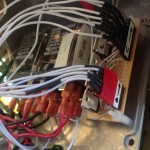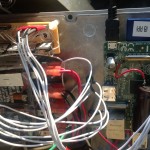My Raspberry PI-based pool controller has been running our pool pumps faithfully for the past 18 months. Every morning, it switches the two pumps on (first one, then the other), and runs them for a few hours (switching them off in reverse sequence). It is really nice to sit out on the deck, go to http://pool/ and switch the pumps on or off without leaving the chair. (It also demos really well…:-))
But when the warm days summer came around this year, it became unreliable. It needed more and more reboots. So it was time to look into the box, and see what was going on.
The first thing I noticed was that the box was warmed than expected. Add some warm days, the sun shining on the metal box, and some faint memories from college about how dramatically silicon performance drops as temperature rises, and the answer was clear: it was getting too hot.
So time to rip out that badly made 12/5V dual power supply I had used, and put in the Adafruit made-for-Raspberry PI 5.25V USB adapter, and a separate 12V adapter. Of course, while I was at it, I also managed to fry one of the MOSFETs driving one of the relays. (Not sure how exactly, but it ended up permanently on.) So, a major revision 2.

This morning it went into the box. It is now more professionally wired (for very low values of professionalism), and it can drive 5 digital output channels (you can see the row of 5 MOSFETs in the picture to the right). Two continue to be wired to the relays. Two additional ones have I connected to a green and a red LED on the box. I don’t know yet what I’ll use them for, probably some kind of “I’m alive” timer; they can be switched via GPIO just like the relays. One is currently unused.
And then, the thing fails to boot! Unscrew everything again, pull out the SDCard, put into a spare Raspberry Pi, and it turns out the SDCard is fried. It produces very awful disk errors. Maybe it was just the disk all along!
I’m writing this as I write for a new SDCard is being initialized. Let’s see how it goes. While I was at it, I decided to make it an Indie Box! This way, it will become much simpler to redeploy my Rasptimer app when there are updates, and to generally keep the box up and running.

Here’s a picture of everything in the box right now: you can see the two big relays driving the 230 V pumps, the row of MOSETs on the little board driving the 12V relays, and of course the Raspberry Pi with a big extra capacitor soldered on to keep its power stable. Not sure I still need it, but it can’t hurt.
Now why do I have to make this, and I can’t simply buy this? Hint hint!
One response to “Raspberry PI Pool controller upgrade”
Andrew Nash liked this on Facebook.